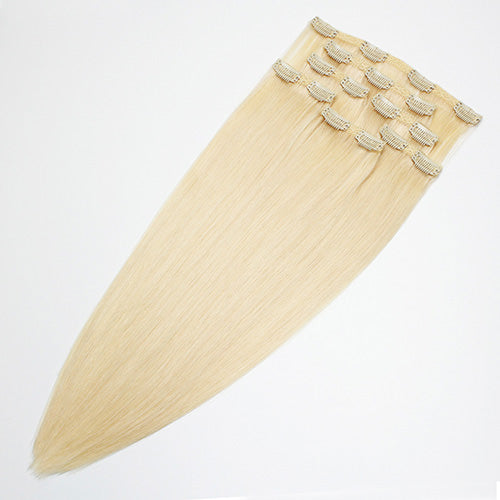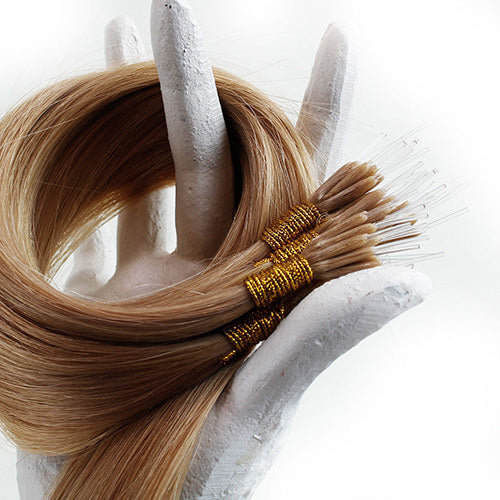
Everything You Need to Know About Split Ends
Types of split ends and using hair extensions to conceal split ends

Beyond what could cause split ends
Split ends, also known as trichoptilosis (trick-cop-til-osis), occurs when the protective outer layer of hair is damaged and the hair splits into two or more strands at the end of your hair. This can cause the hair to look dull and lifeless, and can lead to further breakage if not addressed. Split ends can occur for a variety of reasons, including environmental factors, styling practices, and poor nutrition. In this article, we will explore the causes, kinds, and a way to get rid of them.
Split Ends Hair:
Environmental Factors: Environmental factors such as exposure to sun, wind, and pollution can damage the hair and cause split ends. These elements can strip the hair of its natural oils, making it dry and brittle. Over time, this can cause the hair to split and break making the ends look like feathers.
Style:
Styling practices such as using hot tools, tight hairstyles, and chemical treatments can also cause split ends. Lack of brushing (and subsequent tangling) or rough brushing wet hair. Hot tools such as flat irons and curling irons can dry out the hair, making it more prone to splitting. Tight hairstyles such as braids, buns, and ponytails can put stress on the hair, causing it to break. Chemical treatments such as hair coloring, perming, and relaxing can weaken the hair, leading to split ends too.
What could cause split ends
Poor Nutrition:
Poor nutrition can also contribute to split ends. A lack of vitamins and minerals, such as iron and biotin, can weaken the hair and make it more prone to splitting. Eating a healthy diet that includes plenty of fruits, vegetables, and protein can help prevent split ends.
Different kinds of splits
There are several different kinds of split ends, each of which is caused by different factors on the hair shaft.
Classic Split Ends:
Classic split ends occur when the hair splits into two or more strands at the end and travel up the rest of your client's hair. These are the most common type of split ends and are usually caused by environmental factors and styling practices.
Baby Hairs:
Baby hairs are small, fine hairs that grow along the hairline. When these hairs become damaged, they can split at the end, causing a frizzy, unkempt appearance.
Tree Branch Split Ends:
Tree branch split ends occur when the hair splits into several strands, similar to the branches of a tree. This type of split end is usually caused by severe damage, such as from chemical treatments or excessive heat styling.
How to prevent split end
There are several ways to reduce hair breakage and damage to your client's hair. Lets get onto split ends and what causes hair to break. Proper hair care may help prevent tangles and breakage development of split ends, including:
Trimming:
Regular trims or a haircut can help prevent split ends by removing damaged hair before it has a chance to split further. Recommend that your clients get a trim every six to eight weeks. If you do not trim your client's hair every 6-8 weeks they are susceptible to split ends in the future.
Protective Styling:
Protective styling involves wearing hairstyles that protect your client's hair and minimize stress on the hair as you style the hair. This includes braids, twists, and buns. These styles can help protect the hair from environmental factors and excessive manipulation.
Using Heat Protectant Hair Products:
Using a heat protectant spray or serum can help protect the hair from damage caused by heat styling. These products can create a barrier between the hair and the heat, preventing it from becoming dry and brittle.
Avoiding Tight Hairstyles:
Avoiding tight hairstyles can help prevent split ends by reducing stress on the hair and prevent further splitting. Have your clients opt for loose hairstyles that do not pull on the hair, such as a messy bun or loose ponytail.
Using the Right Hair Products:
Using the right hair products can also help keep your hair free of split ends. Look for products that are specifically designed for your client's hair type and avoid products that contain harsh chemicals or alcohol.
Conclusion: split ends are a common hair health problem that can be caused by a variety of factors. Environmental factors, styling practices, and poor nutrition can all contribute to split ends. There are several different kinds of split ends, each of which is caused by different factors. To prevent split ends, it is important to get regular trims, use a microfiber towel, use a leave-in conditioner, wrap your hair, brush your hair frequently, wash your hair gently , use metal free hair ties, take care of scalp and hair, and cut your client's hair to keep hair healthy.
How to Get Rid of Split Ends
Hair extensions can be a great way to blend split ends

Blend extensions with a client's natural hair gently and address damaged ends
When using hair extensions to blend split ends, it is important to select extensions that closely match the client's natural hair color and texture. This will help ensure that the extensions blend seamlessly and look natural. It is also important to properly care for the extensions to prevent further damage to the client's natural hair. This may include using a gentle shampoo and conditioner, avoiding excessive heat styling, and getting regular maintenance appointments to ensure that the extensions are properly maintained and do not cause damage to the client's natural hair. Hair extensions can be a great way to blend split ends and improve the appearance of a client's hair. With the right techniques and proper care, you can use extensions to create a seamless and natural-looking result that enhances the client's natural beauty.
Here are some of the best extension installation techniques for a hairdresser to recommend:
Clip-In Extensions: Clip-in extensions are a great option for blending split ends because they are easy to use and can be removed and reattached as needed. Clip-in extensions can be worn with or without a topper and are available in a variety of lengths and textures, making it easy for you to find a match for your client's natural hair.

Tape-In Extensions: Tape-in extensions are a great option for blending split ends because they lie flat against the head and can be easily customized to match the client's natural hair color and texture. Tape-in extensions can also be placed strategically to cover split ends and create a fuller look.

These extensions are applied by sandwiching a small section of the client's natural hair between two pieces of adhesive tape, with the extension hair attached to the top tape. You can then use a razor or scissors to carefully blend the client's natural hair with the extension hair, creating a seamless and natural-looking result. This technique can be particularly effective for blending in split ends and creating a fuller, more voluminous look.
LEARN HOW TO INSTALL TAPE-IN EXTENSIONS HERE
Flex Tip Extensions: Nano extensions involve attaching small metal beads or rings to the client's natural hair and threading the extension hair through them. Then using a special tool to clamp the beads or rings shut, securing the extension hair in place. With this technique, you can carefully blend the client's natural hair with the extension hair, creating a seamless and natural-looking result.
LEARN HOW TO INSTALL FLEX-TIP NANO EXTENSIONS HERE

Hand Tied Weft Extensions: Weave extensions involve attaching a track of extension hair to the client's natural hair using a beaded row. This technique is ideal for blending split ends because it can create a fuller, more voluminous look while minimizing damage to the natural hair.
LEARN HOW TO INSTALL HAND-TIED EXTENSIONS

Ultimately, the best hair extensions for blending split ends will depend on the client's individual needs and preferences, as well as their natural hair type and texture. Recommend the best extensions based on these factors and create a customized look that enhances the client's natural beauty.



